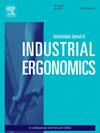高温环境下的扩展个体化双节点人体热模型
IF 3
2区 工程技术
Q2 ENGINEERING, INDUSTRIAL
International Journal of Industrial Ergonomics
Pub Date : 2025-08-01
DOI:10.1016/j.ergon.2025.103792
引用次数: 0
摘要
人体热模型在预测人体热应变方面具有重要的实用性和优越性。基于Gagge的基础,提出了一种先进的双节点人体热模型来模拟高温环境下的个体生理反应。该增强模型结合了高温对代谢率和对流系数的影响,并考虑了体表面积、体温设定点和皮肤血流量的个体变化。此外,还调整了代表服装隔热和防蒸汽性能的参数。八名中国青年——四男四女——穿着两种不同类型的衣服,暴露在高温环境(35°C/ 50% RH)中,重复轻度和中度强度的活动,以验证模型。结果表明,该模型能较好地预测该实验条件下个体的热反应。核心温度和皮肤温度的模拟值与观测值之间的最大差异分别限制在0.3°C和0.6°C。该模型已被初步证明可以可靠地预测特定高温环境下的个体生理反应。然而,目前的框架没有考虑到人体内的水分流失,这是长期热暴露的关键因素。展望未来,可以综合考虑更多的热调节参数,并在各种工况下进行验证,从而更全面地预测高温环境下人体的热应变。本文章由计算机程序翻译,如有差异,请以英文原文为准。
An extended individualized two-node human thermal model for high-temperature environments
The human thermal model offers significant utility and advantages in predicting human heat strain. An advanced two-node human thermal model was proposed based upon Gagge's foundational to simulate individual physiological responses in high-temperature settings. This enhanced model incorporates the impacts of elevated temperatures on metabolic rate and the convective coefficient, and it accounts for individual variations in body surface area, the set points of body temperatures, and skin blood flow. Additionally, adjustments were made to the parameters representing clothing thermal insulation and vapor resistance. eight Chinese youths—four males and four females—were exposed to a high-temperature environment (35 °C/50 % RH) while wearing two different types of clothing to replicate light and moderate intensity activities to validate the model. The findings indicate that the model excels in predicting the thermal responses of individuals under this experimental condition. The maximal discrepancies between simulated and observed values for core and skin temperatures were confined to 0.3 °C and 0.6 °C, respectively. The model has been preliminarily demonstrated to reliably forecast individual physiological responses in given high-temperature environments. Nevertheless, the current framework does not take into account water loss in the human body, which is a key factor in long-term heat exposure. Looking to the future, more thermal regulation parameters can be comprehensively considered, and verified under various working conditions, so as to predict the thermal strain of the human body in high-temperature environments more comprehensively.
求助全文
通过发布文献求助,成功后即可免费获取论文全文。
去求助
来源期刊
CiteScore
6.40
自引率
12.90%
发文量
110
审稿时长
56 days
期刊介绍:
The journal publishes original contributions that add to our understanding of the role of humans in today systems and the interactions thereof with various system components. The journal typically covers the following areas: industrial and occupational ergonomics, design of systems, tools and equipment, human performance measurement and modeling, human productivity, humans in technologically complex systems, and safety. The focus of the articles includes basic theoretical advances, applications, case studies, new methodologies and procedures; and empirical studies.

 求助内容:
求助内容: 应助结果提醒方式:
应助结果提醒方式:


